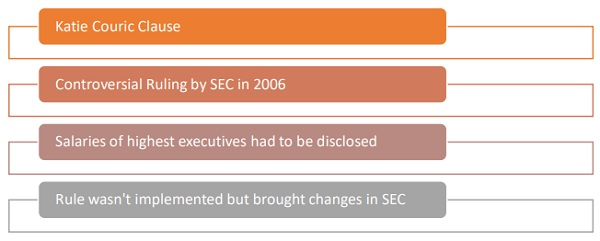
 Data Structure
Data Structure Networking
Networking RDBMS
RDBMS Operating System
Operating System Java
Java MS Excel
MS Excel iOS
iOS HTML
HTML CSS
CSS Android
Android Python
Python C Programming
C Programming C++
C++ C#
C# MongoDB
MongoDB MySQL
MySQL Javascript
Javascript PHP
PHP
- Selected Reading
- UPSC IAS Exams Notes
- Developer's Best Practices
- Questions and Answers
- Effective Resume Writing
- HR Interview Questions
- Computer Glossary
- Who is Who
What is Katie Couric Clause and how does it work?
The Katie Couric Clause is a term coined by the media named after a contentious decision that the Securities and Exchange Commission (SEC) contemplated adopting in 2006. The ruling was first proposed in 2006 and was ultimately rejected. The verdict became known as The Executive Compensation and Related Party Disclosure clause.

Key Points Briefly
It was referred to as the "Katie Couric Clause" when referring to a proposed Securities and Exchange Commission regulation addressing the disclosure of executive pay and the compensation of other select workers.
The rule was proposed in 2006 that businesses be obliged to publicly disclose the salaries and benefits received by up to three of the highest-paid workers at a company other than those in leadership positions.
The regulation put CBS in spotlight and required them to reveal Katie Couric's pay, who was at the time the highest-paid news anchor on the network, in order to comply with the law.
The regulation was met with severe opposition from big media corporations and Wall Street firms and was eventually rejected by Congress.
The need for transparency with CEO pay and top executives was addressed in Dodd-Frank case of 2010.
What is the Katie Couric Clause, and why is it so named?
Katie Couric was the main news host of the popular “Today Show,” and she was named the highest-paid newscaster in the United States in April 2006, surpassing David Letterman. It was dubbed the Katie Couric Clause in reference to a scenario involving Couric's former company, CBS News, at the time. As a result of the passage of the Executive Compensation and Related Party Disclosure Clause, CBS would have been obliged to make Katie Couric's salary available to the public.
What are current SEC compensation rules?
Although the SEC did not adopt the Katie Couric Rule in 2006, new regulations governing the disclosure of information regarding executive compensation were required as a result of the 2010 Dodd-Frank financial reform legislation, which was enacted as a result of the fallout from the 2008 credit crisis.
Executive compensation-related restrictions were entered in the Dodd-Frank Act. Despite the fact that the SEC has not yet authorized all of those requirements as of 2021, there are a few important ones that have already been implemented.
There have been new regulations that have been brought into place after these case that have called for more transparency and openness when it comes to disclosing the compensation of the CEO and other key employees.
Therefore, as a result of this rule, all businesses comply and have to report their financial pay to their top five executives in their annual report. Generally, this includes, the CEO, chief financial officer and three other key executives.
According to other changes in SEC reporting rules, businesses must now include an "Executive Compensation Discussion and Analysis" section in all SEC forms, as well as their compensation paperwork. The section must contain an explanation of how the compensation was calculated as well as what it entails in terms of benefits.

